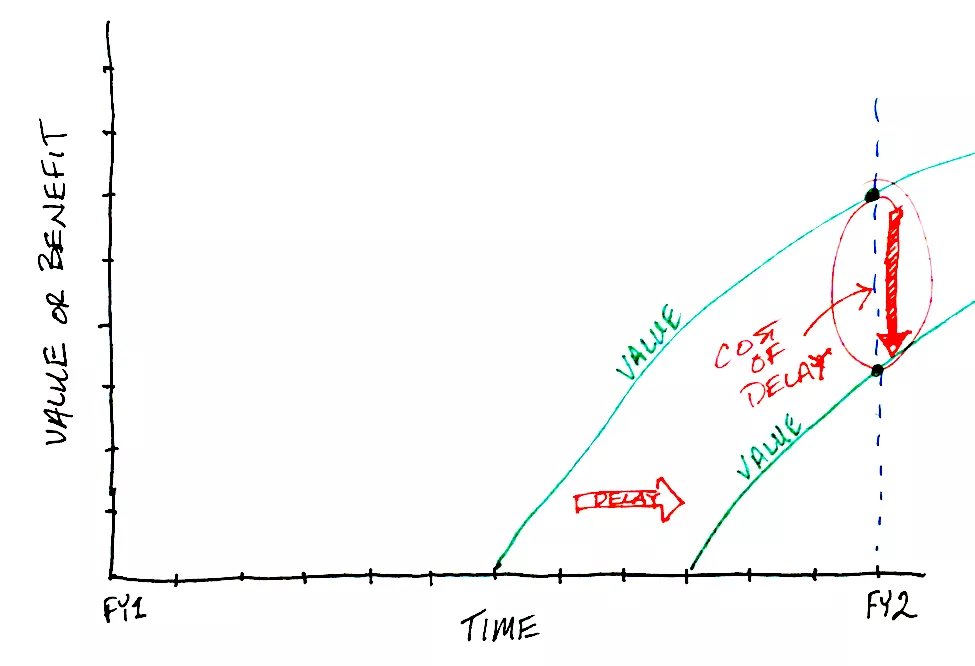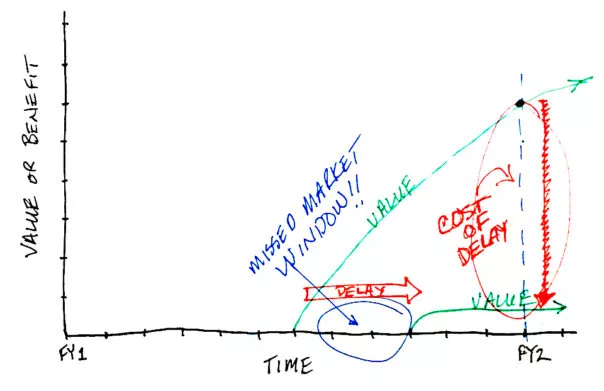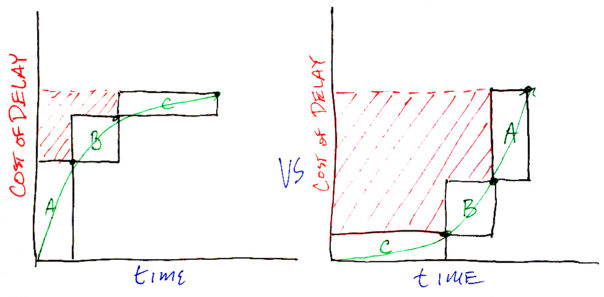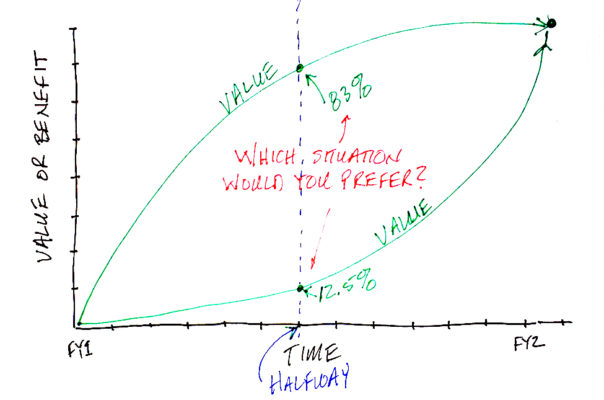Cost of Delay. What Does It Mean?
Oftentimes when I ask Product Owners how they choose which projects their teams focus on first, they don’t have a technique for prioritization. Cost of Delay is a concept that a lot of organizations are using and that has gained traction over the years. Unfortunately, many people are still struggling with the concept of Cost of Delay, so I want to put it down in laymen’s terms here in this blog. Ultimately, the Cost of Delay is a concept that helps you decide—if you have two or more efforts—which order to perform them.
“Cost of Delay” in layman’s terms is the Cost of Delay.
“Well Duh,” you say … doesn’t really help to define the term using the term itself! Thanks a lot!”
You’re absolutely right, so let’s look at it from a pragmatic vantage point. The cost of delay can mean the loss or deferment of a benefit/value due to the delay and/or incursion of some sort of penalty.
For example, we have all experienced the “cost of delay” getting out of the house late to go to work. In Atlanta, a 15-minute delay getting out of the house could result in a 30-minute commute becoming an over-hour nightmare. Couple being late with the “penalty” implications of missing an important meeting, and you can clearly visualize the “cost of delay”.
In business, we do projects to accrue some expected benefit from the result of that work. Delay the realization of that project by a quarter, and you’ve incurred a “Cost” of a quarter’s worth of that benefit this fiscal year.

Miss an expected market window of opportunity and the Cost of Delay will include an even greater penalty.

In Principles of Product Development Flow, Don Reinertsen speaks extensively about Cost of Delay. He leverages a model that visualizes projects as rectangles with their vertical axis as the Cost of Delay and their horizontal as the time it takes to implement them.
Leveraging this model enables us to determine which order to do the projects to minimize the Cost of Delay. We can visualize this by plotting the projects on a waterfall diagram as shown below:

The first project incurs zero Cost of Delay because it was begun immediately. The second project’s Cost of Delay can be visualized as it waits to begin. Likewise, the third project’s Cost of Delay can be envisioned as it waits for the others to complete.
Therefore, doing the projects in the order on the left diagram incurs less cumulative Cost of Delay than the order indicated on the right diagram.
You don’t want to prioritize your projects to start slowly and accelerate at the end. You want them to ramp up early and taper off to minimize the Cost of Delay.

Think of this in a different way … What if we plotted value (above) rather than Cost of Delay. Wouldn’t you rather have 83% of your money in the bank halfway through the time-period vice only 12.5%?
Final Thoughts on Cost of Delay
One thing to keep in mind while prioritizing projects is: overall value is not just money. Nor is all cost paid in dollars. Certainly, you’re looking for a return on investment; however, you also need to consider what will happen to your market share, customer loyalty, and brand integrity as you make tradeoffs to meet or delay deadlines. For example, if you choose to delay a project and your biggest competitor releases their version of your product, what will that do to your market share? On the flip side, what if you rush to market and release buggy software? How will that impact customer loyalty and, perhaps, overall sales? Will it detract from your brand integrity? These nuances should be saved for another blog post, but I’d be remiss if I didn’t mention some of the less obvious, but ultimately tangible, costs associated with delay.
Remember, too, that the value placed on projects is an expected or anticipated value. Companies do projects with the hypothesis that they will result in a certain benefit. What if that hypothesis is incorrect? Wouldn’t you rather have more time to adjust (so you can hit the overall goal) than less time?!? How many times have you or your executives bemoaned “I wish we’d known that sooner!!!” There is certainly a “cost” associated with late feedback!
I hope that this overview of the Cost of Delay is helpful. For far greater detail, please read Don Reinertsen’s book The Principles of Product Development Flow in which he goes to extensive lengths to describe the Cost of Delay.
Lastly, be sure to check out Marty Bradley’s post on the Cost of Delay. Marty has some really good ideas on this stuff too. In his post he even provides this interactive Excel spreadsheet to help you calculate your cost of delay.


Comments (8)
Andrew Reeves-Hall
Thank you for this posting! May I use the drawings in my training of colleagues (credit given)?
Also, the drawing showing the blocks has a mistake, I believe. On the right-hand diagram, box “A” and “B” are reversed (the “A” is a square on left diagram).
Best wishes,
~Andrew~
Absolutely Andrew! Be my guest! Thanks again … and I will correct that labeling! JH
Thanks Andrew…. Sure, you can use the drawings and thanks for catching that switch!
Bhavani
Hi,
You have explanation of CoD is very understandable for a layman per say, thanks for your post :)
My pleasure! Thanks!
Alexander
Hi Jim and thanks for this post.
Shouldn’t we have to distinguish between delay and postponement (or between project delay and delayed product use) – and establish reference points for the delay and postponement?
Interesting. Both would contribute to a delay in receiving the (expected) benefit. I supposed that if you wanted to capture that distinction you could.
Alexander
In general, I would use Cost of Time that is caused by project delay (or acceleration) or postponed (or premature) execution which may induce a cost of project delay or acceleration, a cost of perishable information, a cost of premature delivery, a cost of regulatory and contractual penalties, a cost of lost opportunity, a cost of deferred use of project assets, a cost of customer dissatisfaction with late delivery and a cost of delaying dependent projects.